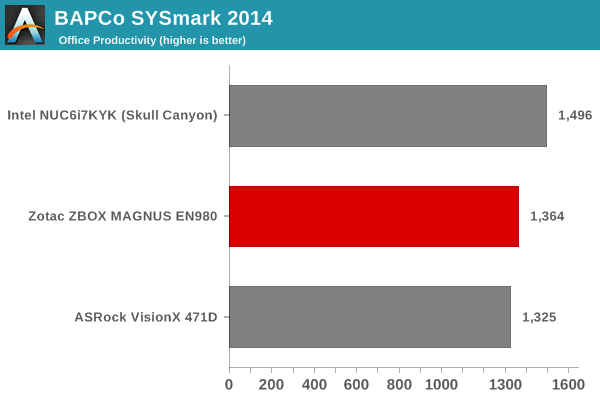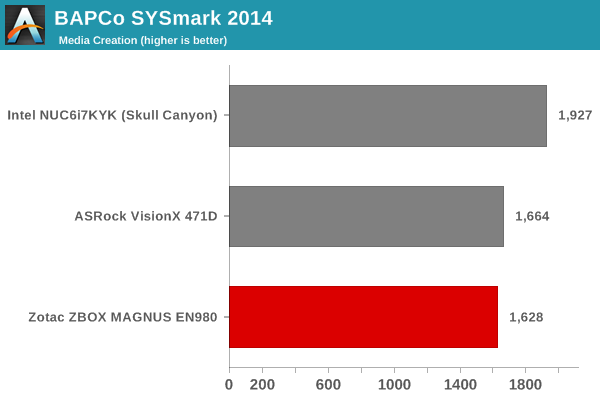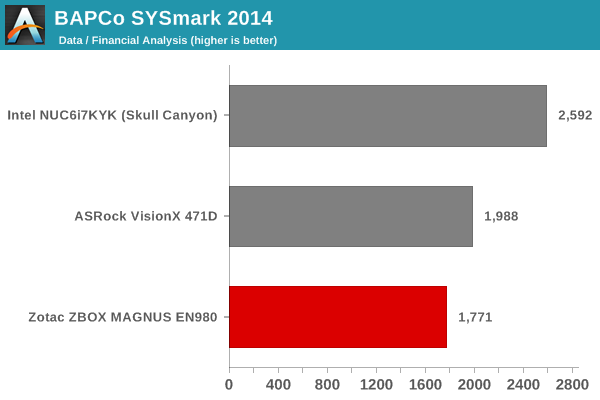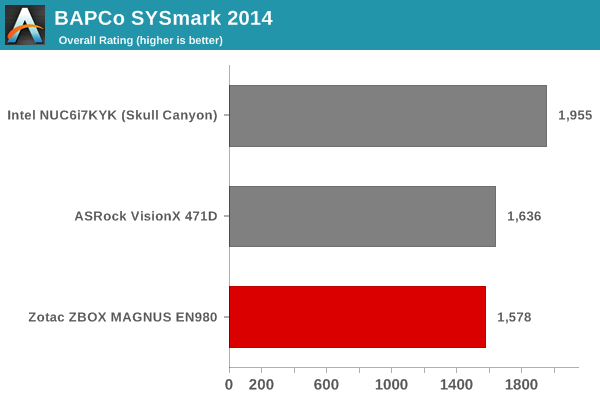Zotac ZBOX MAGNUS EN980 SFF PC Review - An Innovative VR-Ready Gaming Powerhouse
by Ganesh T S on August 25, 2016 8:00 AM ESTPerformance Metrics - I
The Zotac ZBOX MAGNUS EN980 was evaluated using our standard test suite for gaming mini-PCs. Not all benchmarks were processed on all the machines due to updates in our testing procedures. Therefore, the list of PCs in each graph might not be the same. In the first section, we will be looking at SYSmark 2014, as well as some of the Futuremark benchmarks.
BAPCo SYSmark 2014
BAPCo's SYSmark 2014 is an application-based benchmark that uses real-world applications to replay usage patterns of business users in the areas of office productivity, media creation and data/financial analysis. Scores are meant to be compared against a reference desktop (HP ProDesk 600 G1 with a Core i3-4130, 4GB RAM and a 500GB hard drive) that scores 1000 in each of the scenarios. A score of, say, 2000, would imply that the system under test is twice as fast as the reference system.




The SYSmark numbers are a bit of a problem for the MAGNUS EN980 due to the 4C/4T configuration of the Core i5-6400 CPU in it. Since this is a CPU-intensive benchmark, it loses out to better-clocked / higher-thread-count systems such as the Skull Canyon NUC and the mobile Haswell Core i7 in the ASRock VisionX 471D. That said, performance in office and creative applications is probably not of great concern to the target market for the MAGNUS EN980 - hardcore gamers.
Futuremark PCMark 8
PCMark 8 provides various usage scenarios (home, creative and work) and offers ways to benchmark both baseline (CPU-only) as well as OpenCL accelerated (CPU + GPU) performance. We benchmarked select PCs for the OpenCL accelerated performance in all three usage scenarios. These scores are heavily influenced by the CPU in the system. The presence of a discrete GPU and better power budget enables the ZBOX MAGNUS EN980 to make a clean sweep of all the Futuremark benchmark numbers.



Miscellaneous Futuremark Benchmarks





3D Rendering - CINEBENCH R15
We have moved on from R11.5 to R15 for 3D rendering evaluation. CINEBENCH R15 provides three benchmark modes - OpenGL, single threaded and multi-threaded. Evaluation of select PCs in all three modes provided us the following results. The OpenGL performance with the GTX 980 at the helm is a cakewalk for the EN980, but the unit comes in the middle of the pack when it comes to CPU rendering performance for the same reasons that we analyzed in the SYSmark scores section.













30 Comments
View All Comments
nathanddrews - Thursday, August 25, 2016 - link
Revision 2.0 with Pascal and PCIe SSD should be interesting. The tiny design is really neat.Chaitanya - Thursday, August 25, 2016 - link
V2 with 1080 or 1070 has already been announced.nathanddrews - Thursday, August 25, 2016 - link
...ImSpartacus - Thursday, August 25, 2016 - link
That's going to be awesome. I hope they can cram some kaby lake in there as well as it'll surely have some minor improvements over Skylake.lament - Thursday, August 25, 2016 - link
Not v2 though.. different model EN10: http://techreport.com/news/30526/zotac-magnus-en10...Morawka - Thursday, August 25, 2016 - link
Tiny? this thing is huge. sure it's smaller than your typical M-ITX case but not far from it.Einy0 - Friday, August 26, 2016 - link
Is it just me or is a 250GB SSD is not enough for a gaming PC. I thought it would be enough a few years ago and quickly discovered that I was constantly shuffling games over to a HDD to make room. Most of the games from the past few years are about 40GB a piece. Looking at my current Steam folder, the Witcher 3 is 38GB and Shadow of Mordor is 42GB. With Windows 10 and a standard load of common apps and utilities, you are looking at 4 to 5 games installed. I suppose if you only use it for games it would okay.jamyryals - Thursday, August 25, 2016 - link
Looks like a terrific little box. The visual comparison to the Nuc was especially helpful to get size context. Too bad they couldn't get the Pascal cards in on this version.fallaha56 - Thursday, August 25, 2016 - link
too bad? deal breaker more like! no point being this far behind the curve...gtx1060 would wipe floor wit at every levelBrokenCrayons - Thursday, August 25, 2016 - link
It's an interesting system. As already mentioned in another comment, the NUC size comparison is useful for putting things in perspective about just how much more physical space it takes to gain gaming performance.I do question this line though:
"At this point of time, a premium gaming PC that can't be advertised as VR-ready can't get good market reception."
The monetary returns for companies producing VR hardware and VR-enabled software for consumer use isn't easy to find and we haven't had enough time or products out there to see any enduring trends about the latest round. All I've got is personal experience to work with here, but I see very little consumer demand because of the cost of entry and the unaddressed shortcomings that we saw with 90's era headgear being duplicated in current hardware.